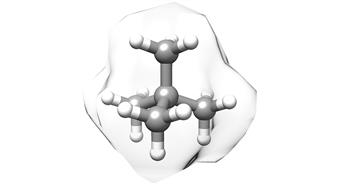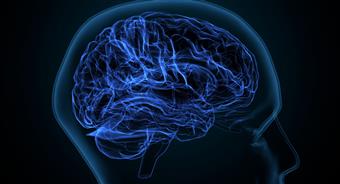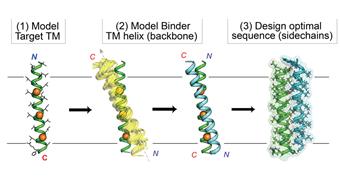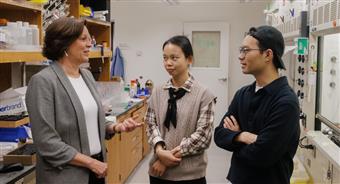
Scientists discover a potential strategy to treat influenza A In a breakthrough with applicability across many flu strains, researchers find a potential small molecule that mimics antibodies to treat disease
March 11, 2019
LA JOLLA, CA A team of researchers from Scripps Research and Janssen Research & Development LLC has discovered an orally active small molecule that neutralizes influenza A group 1 viruses, the most common flu strains. Scientists uncovered the potential therapy in a large chemical library and optimized lead compounds to produce JNJ-4796. Now they have proven its effectiveness against influenza in mice.
What's exciting is that this molecule has the potential to target different strains and subtypes of influenza virus, says co-senior investigator Ian Wilson, PhD, Hansen Professor of Structural Biology at Scripps Research. Not only do influenza A type 1 viruses account for many of the seasonal flu strains, he says, but also pandemic strains, such as H1N1, and emerging strains, such as H5N1.
In a typical year, influenza sickens 5 to 20 percent of the U.S. population, leading to more than 200,000 hospitalizations and 36,000 deaths, according to the Centers for Disease Control and Prevention. Strains of influenza A virus are categorized into group 1 and group 2, and then into further subtypes. Antibodies against the virus often only recognize a handful of similar strains. However, a decade ago, Wilson was part of a team of researchers who described a super- antibody called CR6261 isolated from a healthy human that recognized a part of the virus called the hemagglutinin (HA) stem, which is present across influenza strains.
Since that time, researchers have been striving to use these super-antibodies, known as broadly neutralizing antibodies (bnAbs), to develop approaches which could lead to universal flu vaccines and treatments. However, antibodies themselves are large molecules that can only be given through injections, never as an oral drug, which makes them impractical for treating patients at home. A more practical drug, Wilson theorized, would consist of a small molecule that recognizes the HA stem in the same way as the antibody.
In 2017, researchers at Janssen and Scripps designed an artificial peptide that bound to the same region of the HA stem as CR6261 using information on how other stem bnAbs, FI6v3 and CR9114, bind to and neutralize influenza virus. In the new work, published online in the journal Science, they've taken a different approach to mimicking the antibody's actions.
The researchers turned to a library of more than 500,000 drug-like molecules and, in a high-throughput experiment, tested whether any of the compounds could displace a small protein HB80.4 mimic of bnAb CR6261 from the influenza type 1 HA stem, suggesting that such molecules attached to the same spot on the virus. Multiple molecules turned up as positive on the screen, and optimization to produce better binding and pharmacokinetic properties resulted in JNJ-4796 being the most promising inhibitor. Structural work in the Wilson lab revealed the close mimicry of how JNJ4796 bound to the HA stem compared to bnAb CR6261.
The team went on to show that when mice were given JNJ-4796 for seven days, beginning one day before being infected with 25 times the normally-lethal dose of H1N1 influenza, 100 percent of the mice survived. Moreover, when JNJ-4796 was incubated with human bronchial epithelial cells airway cells affected by a flu infection the compound dramatically lowered levels of the virus present in the tissue 96 hours after infection.
While the current version of JNJ-4796 targets the HA stem of influenza A group 1 viruses, the study revealed structural information on how the molecule binds to the HA stem and what changes could possibly make it act more broadly against other influenza strains. While this manuscript suggests that this may be a potential strategy for the treatment of influenza A, this study was pre-clinical, and further studies would be warranted to pursue this approach.
In addition to pointing towards a potential strategy for the design of new drugs to treat influenza, the new work opens the door to designing other antiviral drugs using a similar antibody-inspired approach.
The molecule is proof-of-principle that antibody-guided drug discovery can work, says co-first author Rameshwar U. Kadam, PhD, a senior research associate at Scripps Research. We can now apply this approach to a whole host of other viruses.
Kadam adds that HIV and Ebola for which neutralizing antibodies are known would be especially useful to study in the same way. While antibodies can cost thousands of dollars per dose, small molecules are cheaper, more shelf-stable, and can be developed into oral compounds that are more convenient for patients. Further research would be required.
In addition to Wilson, van Dongen, and Kadam, authors of the study, A small-molecule fusion inhibitor of influenza virus is orally active in mice, include Divita Garg and Wenli Yu of Scripps Research; and Jarek Juraszek, Edward Lawson, Boerries Brandenburg, Frederike Schmitz, Wim B. G. Schepens, Bart Stoops, Harry A. van Diepen, Mandy Jongeneelen, Chan Tang, Jan Vermond, Alida van Eijgen-Obregoso Real, Sven Blokland, Wouter Goutier, Ellen Lanckacker, Jaco M. Klap, Dani lle C. G. Peeters, Jin Wu, Christophe Buyck, Tim H. M. Jonckers, Dirk Roymans, Peter Roevens, Ronald Vogels, Wouter Koudstaal, Robert H. E. Friesen, Pierre Raboisson, Dashyant Dhanak, and Jaap Goudsmit of Janssen.
This work was supported by funding from the National Institutes of Health (R56 AI117675 and R56 AI127371) and the Swiss National Science Foundation. Use of the Stanford Synchrotron Radiation Lightsource to collect x-ray datasets was supported by the U.S. Department of Energy (contract DE-AC02-76SF00515). The SSRL Stru
More from Scripps
20/04/2024
New copper-catalyzed C-H activation strategy from Scripps Research Two-mode reactions inspired by human detox enzymes offer powerful new tools for drug discover...
12/04/2024
Scripps Research chemists devise easier new method for making a common type of building block for drugs Scientists transform simple linear amines into saturated...
06/04/2024
A simple, inexpensive way to make carbon atoms bind together A Scripps Research team uncovers a cost-effective method for producing quaternary carbon molecules,...
04/04/2024
Developing a vaccine for the zombie drug xylazine Scripps Research chemical biologists design an early proof-of-concept vaccine that could lead to the first...
30/03/2024
How blocking a neural receptor responsible for addiction could reduce alcohol use A Scripps Research team found that a new therapeutic that targets the kappa op...
13/03/2024
New computational strategy boosts the ability of drug designers to target proteins inside the membrane Customized-design approach could streamline the design of...
29/02/2024
Scripps Research scientists reveal how first cells could have formed on Earth New phospholipid discovery brings researchers closer to understanding how primordi...
29/02/2024
How molecular handedness emerged in early biology Scripps Research chemists fill a major gap in origin-of-life theories.
February 28, 2024
LA JOLLA, CA Mole...
22/02/2024
Snaking toward a universal antivenom Scripps Research scientists discovered antibodies that protect against a host of lethal snake venoms.
February 21, 2024
...
06/02/2024
Calibr-Skaggs announces expansion of option and license agreement with AbbVie to develop novel cell therapies for solid tumors and autoimmune diseases
AbbVie...
26/01/2024
Re-energizing mitochondria to treat Alzheimer's disease Scripps Research team restored neuron-to-neuron connections in human cells.
January 25, 2024
LA JO...
24/01/2024
100 years of Science Changing Life: Scripps Research celebrates a century of transforming human health For the last century, institute leaders and renowned scie...
23/01/2024
New technology lets researchers track brain cells' off switches The method could shed light on what goes awry in numerous brain conditions when neurons ar...
09/01/2024
Three decades of giving: Announcing the Calibr-Skaggs Institute for Innovative Medicines The ALSAM Foundation, founded by the Skaggs family, provides lasting g...
04/01/2024
Life science entrepreneur Gene Lay joins Scripps Research Board of Directors Lay, founder of the global biotech company BioLegend, brings invaluable experience ...
21/12/2023
Taming a plant-derived toxin Scripps Research team modifies the traditional poison picrotoxinin for potential neurological drugs and anti-parasite treatments. ...
19/12/2023
Scripps Research Executive Vice President Eric Topol gives TED talk on transformative power of AI in medicine Topol provides an overview of how AI models can i...
13/12/2023
New AI-powered algorithm could better assess people's risk of common heart condition Early detection of atrial fibrillation can reduce the risk of stroke an...
07/12/2023
Nanoparticle flu vaccine design shows promise in early tests Scripps Research-designed vaccine could provide broad, enduring protection against influenza A str...
16/11/2023
Numerous Scripps Research scientists named Highly Cited Researchers Clarivate's annual, global list represents researchers who have demonstrated significant...
07/11/2023
Multiple sclerosis drug invented at Scripps Research slows long-term devastating disease progression Late-breaking data reinforces the effectiveness and safety ...
05/10/2023
Keren Lasker named a 2023 Moore Inventor Fellow The prestigious award will support Lasker's inventive research in membraneless organelles and their applica...
22/09/2023
Michael Bollong named a 2023 Amgen Young Investigator The prestigious award will support Bollong's research identifying new molecular targets and therapeuti...
09/09/2023
Philip Dawson receives 2024 American Chemical Society National Award Dawson is honored with the Arthur C. Cope Late Careers Scholar Award for his foundational c...
07/09/2023
Scripps Research chemists devise a method for C-H activation of alcohols The method represents a new toolkit for making drugs and other compounds.
September 06...
31/08/2023
Scripps Research receives $1.5M to surveil infectious disease threats in wastewater Bill & Melinda Gates Foundation award to support the development of multi-pa...
16/08/2023
How cold temperatures trigger the brain to boost appetite Scripps Research scientists' discovery could lead to new weight loss and metabolic health treatmen...
08/08/2023
Human antibody that targets carfentanil, fentanyl and related opioids reverses overdose effects in preclinical study Scripps Research-developed antibody therapy...
04/08/2023
How sensory neurons impact the gut Scripps Research scientists show that the receptor PIEZO2 in sensory neurons controls gut motility and transit time, which a...
26/07/2023
AbbVie and Calibr Expand Strategic Collaboration to Advance Several Preclinical and Early-stage Clinical Assets The expanded strategic collaboration will advan...
23/07/2023
Scripps Research scientists develop AI-based tracking and early-warning system for viral pandemics Machine-learning system effectively predicts emergence of pro...
19/07/2023
Monitoring T cells may allow prevention of type 1 diabetes Scripps Research study shows that analyzing T cells in blood samples could be used to select at-risk ...
19/07/2023
Scripps Research mourns passing of leading organic chemist Albert Eschenmoser Eschenmoser pioneered key reactions in synthetic chemistry and shaped the understa...
15/06/2023
Scripps Research awarded $46.8 million by NIH to promote human health through innovative translational science and training The Translational Institute is harne...
13/06/2023
Scripps Research's Danielle Grotjahn named 2023 Pew Scholar in the Biomedical Sciences The award will support Grotjahn's study of how cells assemble the...
31/05/2023
Crossing the ring: new method enables C-H activation across saturated carbocycles Scripps Research chemists add another powerful tool to their molecular editin...
24/05/2023
Scripps Research develops behind-the-scenes tool for better biomedical data discovery The new resource makes datasets more discoverable for life science communi...
19/05/2023
Scripps Research neuroscientist Hollis Cline elected to American Academy of Arts and Sciences Cline is recognized for her discoveries about the role of sensory ...
19/05/2023
Scripps Research's Skaggs Graduate School awards doctoral degrees to 31st graduating class Commencement ceremony will be livestreamed via Zoom and on instit...
13/05/2023
A better route to benzocyclobutenes, sought-after building blocks for drugs Scripps Research chemists devise a new, C-H activation-based method for the synthesi...
09/05/2023
Renowned Scripps Research professor Jeffery Kelly elected to National Academy of Sciences Kelly's groundbreaking work on protein misfolding has led to thera...
28/04/2023
Mirror-image molecules pave new path for cancer drug discovery By comparing how mirror image versions of small molecules impact clusters of proteins, Scripps R...
22/04/2023
How alcohol consumption contributes to chronic pain A Scripps Research team showed how both alcohol intake and alcohol withdrawal can lead to increased pain and...
21/04/2023
Xin Jin receives dual awards to study autism risk genes in neurodevelopment Major grants from the National Institutes of Health and California Institute for Reg...
20/04/2023
Trim the sugar: New HIV vaccine design improves immune response Scripps Research vaccine candidate headed for clinical trials.
April 19, 2023
LA JOLLA, CA A...
18/04/2023
Therapeutic can seek and destroy potent opioid to treat overdoses Scripps Research chemists developed a new biologic to work against the synthetic opioid carfen...
07/03/2023
How heavy alcohol consumption increases brain inflammation The findings by a Scripps Research team point toward a potential new drug target for treating alcohol...
02/03/2023
Scientists find human antibodies that can block multiple coronaviruses including SARS-CoV-2 Results from a Scripps Research and UNC team pave the way for a vacc...
28/02/2023
$10 million grant funds Scripps Research Alcohol Research Center through its 50th year The five-year grant supports research into the neurobiology of alcohol us...
28/02/2023
Immune system drug shows promise in treating alcohol use disorder, a Scripps Research clinical trial reports Scientists at Scripps Research found that apremilas...
 Scientists discover a potential strategy to treat influenza A In a breakthrough with applicability across many flu strains, researchers find a potential small molecule that mimics antibodies to treat disease
Scientists discover a potential strategy to treat influenza A In a breakthrough with applicability across many flu strains, researchers find a potential small molecule that mimics antibodies to treat disease























